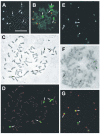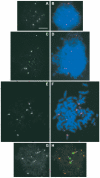NORs and their transcription competence during the cell cycle
- PMID: 17089916
- PMCID: PMC2446406
NORs and their transcription competence during the cell cycle
Abstract
In human cells ribosomal genes are organized as clusters, NORs, situated on the short arms of acrocentric chromosomes. It was found that essential components of the RNA polymerase I transcription machinery, including UBF, can be detected on some NORs, termed "competent" NORs, during mitosis. The competent NORs are believed to be transcriptionally active during interphase. However, since individual NORs were not observed in the cell nucleus, their interphase status remains unclear. To address this problem, we detected the competent NORs by two commonly used methods, UBF immunofluorescence and silver staining, and combined them with FISH for visualization of rDNA and/or specific chromosomes. We found that the numbers of competent NORs on specific chromosomes were largely conserved in the subsequent cell cycles, with certain NOR-bearing homologues displaying a very stable pattern of competence. Importantly, those and only those NORs that were loaded with UBF incorporated bromo-uridine in metaphase after stimulation with roscovitine and in telophase, suggesting that competent and only competent NORs contain ribosomal genes transcriptionally active during interphase. Applying premature chromosome condensation with calyculin A, we visualized individual NORs in interphase cells, and found the same pattern of competence as observed in the mitotic chromosomes.
Figures






References
-
- Babu KA, Verma RS. Structural and functional aspects of nucleolar organizer regions (NORs) of human chromosomes. Int. Rev. Cytol. 1985;94:151–176. - PubMed
-
- Bazett-Jones DP, Leblanc B, Herfort M, Moss T. Short-range DNA looping by the Xenopus HMG-box transcription factor, xUBF. Science. 1994;264:1134–1137. - PubMed
-
- Bezrookove V, Smits R, Moeslein G, Fodde R, Tanke HJ, Raap AK, Darroudi F. Premature chromosome condensation revisited: a novel chemical approach permits efficient cytogenetic analysis of cancers. Genes Chromosomes Cancer. 2003;38:177–186. - PubMed
-
- Bui HT, Yamaoka E, Miyano T. Involvement of histone H3 (Ser10) phosphorylation in chromosome condensation without Cdc2 kinase and mitogen-activated protein kinase activation in pig oocytes. Biol. Reprod. 2004;70:1843–1851. - PubMed
-
- Busch H, Smetana K. The Nucleolus. New York: Academic Press; 1970.
Publication types
MeSH terms
Substances
Grants and funding
LinkOut - more resources
Full Text Sources
